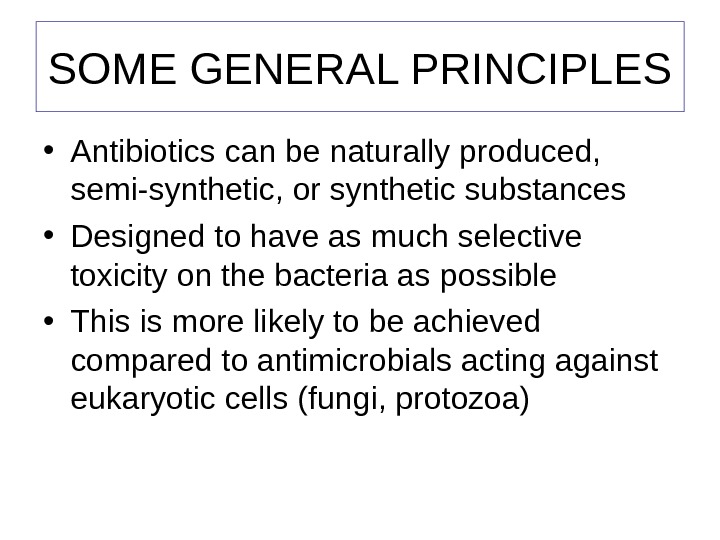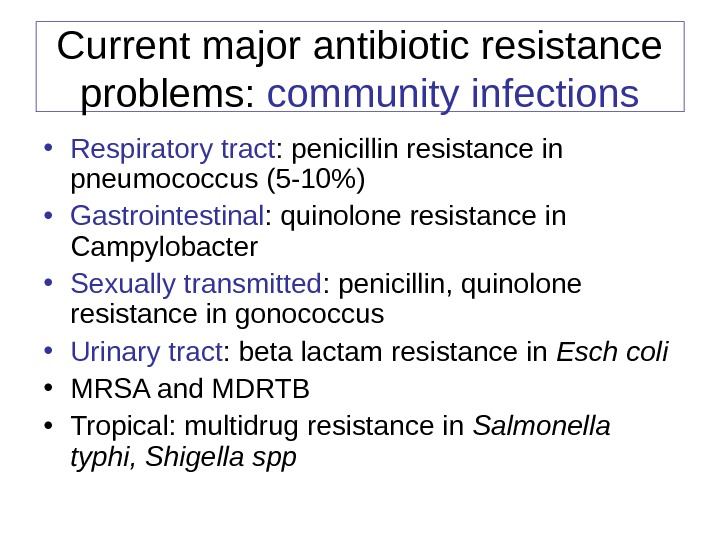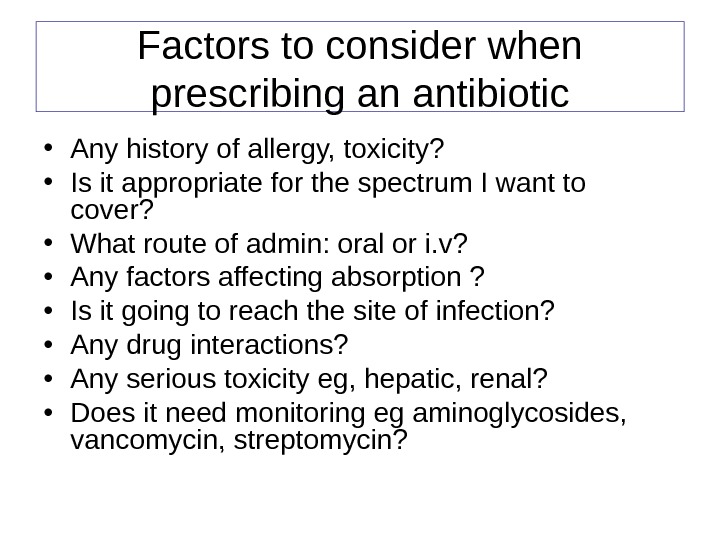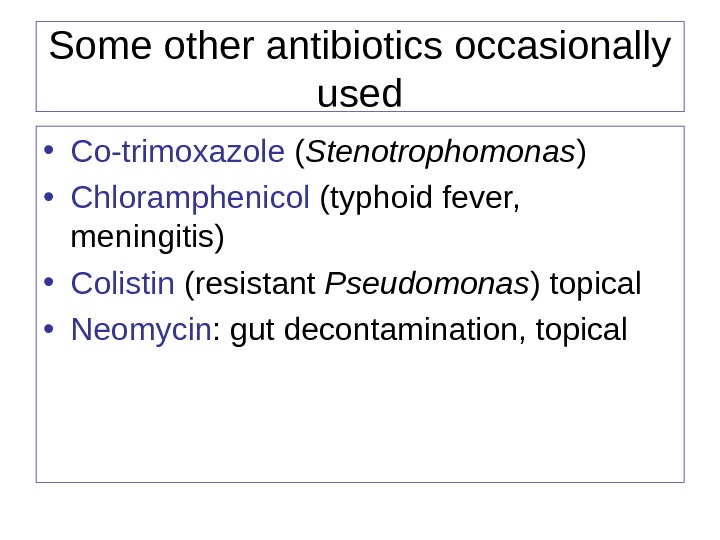ANTIBIOTICS SOME GENERAL PRINCIPLES • Antibiotics






























- Размер: 140.5 Кб
- Количество слайдов: 29
Описание презентации ANTIBIOTICS SOME GENERAL PRINCIPLES • Antibiotics по слайдам
 ANTIBIOTICS
ANTIBIOTICS
 SOME GENERAL PRINCIPLES • Antibiotics can be naturally produced, semi-synthetic, or synthetic substances • Designed to have as much selective toxicity on the bacteria as possible • This is more likely to be achieved compared to antimicrobials acting against eukaryotic cells (fungi, protozoa)
SOME GENERAL PRINCIPLES • Antibiotics can be naturally produced, semi-synthetic, or synthetic substances • Designed to have as much selective toxicity on the bacteria as possible • This is more likely to be achieved compared to antimicrobials acting against eukaryotic cells (fungi, protozoa)
 EXAMPLES OF SELECTIVE ACTION • Penicillin on bacterial cell wall (organisms without cell wall won’t be inhibited eg Mycoplasma pneumoniae) • Sulphonamides prevent bacteria synthesising folic acid whereas humans can use preformed folate • Generally drugs acting on cell membranes or protein synthesis are more toxic to humans
EXAMPLES OF SELECTIVE ACTION • Penicillin on bacterial cell wall (organisms without cell wall won’t be inhibited eg Mycoplasma pneumoniae) • Sulphonamides prevent bacteria synthesising folic acid whereas humans can use preformed folate • Generally drugs acting on cell membranes or protein synthesis are more toxic to humans
 ANTIBIOTICS ACTING ON CELL WALL OF BACTERIA • Beta lactams : • Penicillins, cephalosporins, carbapenems, monobactam • Glycopeptides: • Vancomycin, teicoplanin
ANTIBIOTICS ACTING ON CELL WALL OF BACTERIA • Beta lactams : • Penicillins, cephalosporins, carbapenems, monobactam • Glycopeptides: • Vancomycin, teicoplanin
 THE IDEAL ANTIBIOTIC? : PENICILLIN • Narrow spectrum • Bactericidal • Very selective mode of action • Low serum protein binding • Widely distributed in body esp. CNS • Excreted by the kidneys
THE IDEAL ANTIBIOTIC? : PENICILLIN • Narrow spectrum • Bactericidal • Very selective mode of action • Low serum protein binding • Widely distributed in body esp. CNS • Excreted by the kidneys
 THE DEVELOPMENT OF THE BETA LACTAMS • Benzylenicillin and early cephalosporins mainly active against gram positive bacteria (strep and staph) • Then “broad spectrum” penicillins appeared: ampicillin, ureidopenicillins and cephalosporins : cefuroxime, cefotaxime • Carbapenems and latest generation of cephalosporins, eg ceftazidime more active against gram negatives
THE DEVELOPMENT OF THE BETA LACTAMS • Benzylenicillin and early cephalosporins mainly active against gram positive bacteria (strep and staph) • Then “broad spectrum” penicillins appeared: ampicillin, ureidopenicillins and cephalosporins : cefuroxime, cefotaxime • Carbapenems and latest generation of cephalosporins, eg ceftazidime more active against gram negatives
 BENZYLPENICILLIN: MAIN INDICATIONS Strep pyogenes sepsis (from sore throat to fasciitis) Pneumococcal pneumonia, meningitis Meningococcal meningitis, sepsis Infective endocarditis (strep) Strep group B sepsis Diphtheria Syphilis, leptospirosis
BENZYLPENICILLIN: MAIN INDICATIONS Strep pyogenes sepsis (from sore throat to fasciitis) Pneumococcal pneumonia, meningitis Meningococcal meningitis, sepsis Infective endocarditis (strep) Strep group B sepsis Diphtheria Syphilis, leptospirosis
 Broader spectrum penicillins • Ampicillin, amoxycillin cover most organisms hit by penicillin but also Esch coli, some Proteus (cause UTI’s) • Augmentin stable to TEM 1 beta lactamase because of the clavulanic acid therefore more active than ampicillin • Tazocin: broader coverage than augmentin against gram negatives including Pseudomonas
Broader spectrum penicillins • Ampicillin, amoxycillin cover most organisms hit by penicillin but also Esch coli, some Proteus (cause UTI’s) • Augmentin stable to TEM 1 beta lactamase because of the clavulanic acid therefore more active than ampicillin • Tazocin: broader coverage than augmentin against gram negatives including Pseudomonas
 Organisms producing TEM 1 beta lactamase • Haemophilus influenzae • Neisseria gonorrhoeae • Bacteroides fragilis • Staph aureus • Esch coli
Organisms producing TEM 1 beta lactamase • Haemophilus influenzae • Neisseria gonorrhoeae • Bacteroides fragilis • Staph aureus • Esch coli
 Carbapenems • Imipenem, meropenem : have a very broad spectrum activity against gram-negative bacteria, anaerobes, streps • Now used to treat gram negative infections due to so called ESBL producing organisms eg, E coli, Klebsiella • Ertapenem is a new member of the group but its not active against Pseudomonas
Carbapenems • Imipenem, meropenem : have a very broad spectrum activity against gram-negative bacteria, anaerobes, streps • Now used to treat gram negative infections due to so called ESBL producing organisms eg, E coli, Klebsiella • Ertapenem is a new member of the group but its not active against Pseudomonas
 PENICILLIN IS GENERALLY VERY SAFE BUT…. • Allergic reactions not uncommon-rashes • Most severe reaction being anaphylaxis • A history of anaphylaxis, urticaria, or rash immediately after penicillin indicates risk of immediate hypersensitivity after a further dose of any penicillin or cephalosporin (therefore these must be avoided) • Allergy is not dependent on the dose given ie, a small dose could cause anaphylaxis • Very high doses of penicillin cause neurotoxicity • Never give penicillin intrathecally
PENICILLIN IS GENERALLY VERY SAFE BUT…. • Allergic reactions not uncommon-rashes • Most severe reaction being anaphylaxis • A history of anaphylaxis, urticaria, or rash immediately after penicillin indicates risk of immediate hypersensitivity after a further dose of any penicillin or cephalosporin (therefore these must be avoided) • Allergy is not dependent on the dose given ie, a small dose could cause anaphylaxis • Very high doses of penicillin cause neurotoxicity • Never give penicillin intrathecally
 What antibiotics can be used in penicillin allergy? • Macrolides : erythromycin, clarithromycin • (mainly gram positive cover) • Quinolones : ciprofloxacin, levofloxacin (mainly gram positive cover) • Glycopeptides (serious infections) • Fusidic acid, rifampicin, clindamycin (mainly gram positive)
What antibiotics can be used in penicillin allergy? • Macrolides : erythromycin, clarithromycin • (mainly gram positive cover) • Quinolones : ciprofloxacin, levofloxacin (mainly gram positive cover) • Glycopeptides (serious infections) • Fusidic acid, rifampicin, clindamycin (mainly gram positive)
 REMEMBER WHAT THE OTHER BETA LACTAMS ARE: • All penicillins: ampicillin, augmentin, piperacillin, cloxacillin • Cephalosporins : cefuroxime, cefotaxime, ceftriaxone, ceftazidime (5 -10% cross sensitivity) • Monobactam : aztreonam (low cross sensitivity) • Carbapenems: imipenem, meropenem
REMEMBER WHAT THE OTHER BETA LACTAMS ARE: • All penicillins: ampicillin, augmentin, piperacillin, cloxacillin • Cephalosporins : cefuroxime, cefotaxime, ceftriaxone, ceftazidime (5 -10% cross sensitivity) • Monobactam : aztreonam (low cross sensitivity) • Carbapenems: imipenem, meropenem
 CLOXACILLIN • Narrow spectrum: Staph aureus (MSSA) • Stable to TEM 1 beta lactamase • Similar antibiotics are methicillin, nafcillin • Similar safety profile to benzylpenicillin • MRSA emerged in the early 1970’s ( Mec. A gene encoding additional pbp)
CLOXACILLIN • Narrow spectrum: Staph aureus (MSSA) • Stable to TEM 1 beta lactamase • Similar antibiotics are methicillin, nafcillin • Similar safety profile to benzylpenicillin • MRSA emerged in the early 1970’s ( Mec. A gene encoding additional pbp)
 Cephalosporins: main uses • Cefuroxime : surgical prophylaxis • Cefotaxime/ceftriaxone : meningitis nosocomial infections excluding Pseudomonal, • Ceftazidime : nosocomial infections including Pseudomonal
Cephalosporins: main uses • Cefuroxime : surgical prophylaxis • Cefotaxime/ceftriaxone : meningitis nosocomial infections excluding Pseudomonal, • Ceftazidime : nosocomial infections including Pseudomonal
 Problems with antibiotic resistance: how does it happen? • Some bacteria are naturally resistant to particular antibiotics ( Pseudomonas has permeability barrier to many antibiotics) • Some typically susceptible species have minority populations which are resistant by virtue of mutational resistance (pneumococcus) • Other species acquire resistance via plasmids (“infectious resistance”) eg Neisseria gonorrhoeae, many gram negatives
Problems with antibiotic resistance: how does it happen? • Some bacteria are naturally resistant to particular antibiotics ( Pseudomonas has permeability barrier to many antibiotics) • Some typically susceptible species have minority populations which are resistant by virtue of mutational resistance (pneumococcus) • Other species acquire resistance via plasmids (“infectious resistance”) eg Neisseria gonorrhoeae, many gram negatives
 Current major antibiotic resistance problems: community infections • Respiratory tract : penicillin resistance in pneumococcus (5 -10%) • Gastrointestinal : quinolone resistance in Campylobacter • Sexually transmitted : penicillin, quinolone resistance in gonococcus • Urinary tract : beta lactam resistance in Esch coli • MRSA and MDRTB • Tropical: multidrug resistance in Salmonella typhi, Shigella spp
Current major antibiotic resistance problems: community infections • Respiratory tract : penicillin resistance in pneumococcus (5 -10%) • Gastrointestinal : quinolone resistance in Campylobacter • Sexually transmitted : penicillin, quinolone resistance in gonococcus • Urinary tract : beta lactam resistance in Esch coli • MRSA and MDRTB • Tropical: multidrug resistance in Salmonella typhi, Shigella spp
 Current major resistance problems: hospital infections • MRSA : current strains are often multiply-antibiotic resistant • VISA/GISA : intermediate resistance to glycopeptides (thickened cell wall) • VRSA/GRSA : highly resistant (transferable on plasmids) from enterococci • VRE : enterococci (multiply resis tant) • Broad spectrum beta lactam resistant ( ESBL ) Esch coli, Klebsiella • Multiply antibiotic resistant enterobacteria: Acinetobacter, Stenotrophomonas, Serratia
Current major resistance problems: hospital infections • MRSA : current strains are often multiply-antibiotic resistant • VISA/GISA : intermediate resistance to glycopeptides (thickened cell wall) • VRSA/GRSA : highly resistant (transferable on plasmids) from enterococci • VRE : enterococci (multiply resis tant) • Broad spectrum beta lactam resistant ( ESBL ) Esch coli, Klebsiella • Multiply antibiotic resistant enterobacteria: Acinetobacter, Stenotrophomonas, Serratia
 Other major antibiotic groups: aminoglycosides • Gentamicin, amikacin (tobramycin, streptomycin) • Mainly active against gram negative bacteria • Mainly used to treat nosocomial infections: pneumonia in ITU, septicaemia • Limiting factors are nephrotoxicity (and ototoxicity) and resistance • Also used in combination
Other major antibiotic groups: aminoglycosides • Gentamicin, amikacin (tobramycin, streptomycin) • Mainly active against gram negative bacteria • Mainly used to treat nosocomial infections: pneumonia in ITU, septicaemia • Limiting factors are nephrotoxicity (and ototoxicity) and resistance • Also used in combination
 How we give aminoglycosides • For serious nosocomial infections: “extended interval” or once daily dosing • 5 or 7 mg/kg for gentamicin (Hartford nomogram) • Rationale based on concentration- dependent killing and post-antibiotic effect • Reduced risk of nephrotoxicity • In infective endocarditis use lower doses to give synergy with penicillin
How we give aminoglycosides • For serious nosocomial infections: “extended interval” or once daily dosing • 5 or 7 mg/kg for gentamicin (Hartford nomogram) • Rationale based on concentration- dependent killing and post-antibiotic effect • Reduced risk of nephrotoxicity • In infective endocarditis use lower doses to give synergy with penicillin
 Some indications and limitations of particular antibiotics
Some indications and limitations of particular antibiotics
 Community acquired pneumonia • Pneumococcus (and H influenzae ) are most likely: therefore ampicillin, amoxycillin or augmentin • Severe pneumonia: cefotaxime • Severe atypical pneumonia ( Legionella ): macrolide or quinolone • Resistant pneumococcus: vancomycin or linezolid (new antibiotic!) • A new quinolone moxifloxacin covers most of these pathogens (likely to be used more in community)
Community acquired pneumonia • Pneumococcus (and H influenzae ) are most likely: therefore ampicillin, amoxycillin or augmentin • Severe pneumonia: cefotaxime • Severe atypical pneumonia ( Legionella ): macrolide or quinolone • Resistant pneumococcus: vancomycin or linezolid (new antibiotic!) • A new quinolone moxifloxacin covers most of these pathogens (likely to be used more in community)
 Community acquired urinary infections • Ampicillin, amoxycillin, augmentin • Oral cephalosporin: cephradine • Trimethroprim • Nalidixic acid • Nitrofurantoin • Ciprofloxacin • Mecillinam
Community acquired urinary infections • Ampicillin, amoxycillin, augmentin • Oral cephalosporin: cephradine • Trimethroprim • Nalidixic acid • Nitrofurantoin • Ciprofloxacin • Mecillinam
 Skin and soft tissue infections • Cellulitis ? Streptococcal: penicillin or augmentin • Infected eczema ? Staphylococccal/mixed: penicillin+flucloxacillin or augmentin • Necrotising fasciitis: penicillin+clindamycin • Septic arthritis: fluclox+fusidic acid • Gangrene: metronidazole
Skin and soft tissue infections • Cellulitis ? Streptococcal: penicillin or augmentin • Infected eczema ? Staphylococccal/mixed: penicillin+flucloxacillin or augmentin • Necrotising fasciitis: penicillin+clindamycin • Septic arthritis: fluclox+fusidic acid • Gangrene: metronidazole
 Where there is deep-seated infection: bone, abscess • Need an antibiotic with good tissue and phagocyte penetration • Examples are rifampicin, clindamycin, fusidic acid, ciprofloxacin, metronidazole • So for treatment of Staph aureus osteomyelitis: flucloxacillin+ fusidic acid
Where there is deep-seated infection: bone, abscess • Need an antibiotic with good tissue and phagocyte penetration • Examples are rifampicin, clindamycin, fusidic acid, ciprofloxacin, metronidazole • So for treatment of Staph aureus osteomyelitis: flucloxacillin+ fusidic acid
 Why do we use combination therapy? • When treating serious infection empirically we want to cover a broad spectrum (severe pneumonia: cefotaxime+erythromycin) • To prevent the emergence of drug resistance: tuberculosis regimens • For synergy: infective endocarditis (aminoglycoside) • For mixed infections eg, abdominal sepsis (tazocin+metronidazole)
Why do we use combination therapy? • When treating serious infection empirically we want to cover a broad spectrum (severe pneumonia: cefotaxime+erythromycin) • To prevent the emergence of drug resistance: tuberculosis regimens • For synergy: infective endocarditis (aminoglycoside) • For mixed infections eg, abdominal sepsis (tazocin+metronidazole)
 Factors to consider when prescribing an antibiotic • Any history of allergy, toxicity? • Is it appropriate for the spectrum I want to cover? • What route of admin: oral or i. v? • Any factors affecting absorption ? • Is it going to reach the site of infection? • Any drug interactions? • Any serious toxicity eg, hepatic, renal? • Does it need monitoring eg aminoglycosides, vancomycin, streptomycin?
Factors to consider when prescribing an antibiotic • Any history of allergy, toxicity? • Is it appropriate for the spectrum I want to cover? • What route of admin: oral or i. v? • Any factors affecting absorption ? • Is it going to reach the site of infection? • Any drug interactions? • Any serious toxicity eg, hepatic, renal? • Does it need monitoring eg aminoglycosides, vancomycin, streptomycin?
 Some other antibiotics occasionally used • Co-trimoxazole ( Stenotrophomonas ) • Chloramphenicol (typhoid fever, meningitis) • Colistin (resistant Pseudomonas ) topical • Neomycin : gut decontamination, topical
Some other antibiotics occasionally used • Co-trimoxazole ( Stenotrophomonas ) • Chloramphenicol (typhoid fever, meningitis) • Colistin (resistant Pseudomonas ) topical • Neomycin : gut decontamination, topical
 Special situations • Paediatrics • Obesity • Renal failure (haemodialysis/filtration) • Hepatic failure • CNS infections • Epidemiology (contacts of cases
Special situations • Paediatrics • Obesity • Renal failure (haemodialysis/filtration) • Hepatic failure • CNS infections • Epidemiology (contacts of cases

